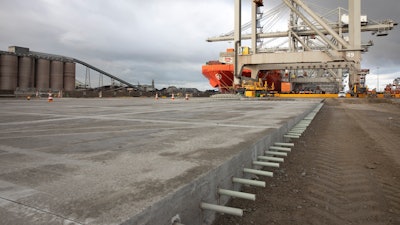Composites: The Future of Lasting Building And Construction Products
Composites: The Future of Lasting Building And Construction Products
Blog Article
Unlocking the Ecological Benefits of Recycled Compounds in Building and Design
In the world of construction and design, the application of recycled composites holds considerable guarantee for boosting sustainability techniques and reducing ecological impact. The change towards an extra sustainable future in these industries pivots on opening the full possibility of recycled compounds.

Ecological Impact Reduction
The decrease of ecological impact with making use of recycled compounds in building and layout plays an essential function in sustainable methods. By integrating recycled compounds right into structure materials, the building and construction sector can substantially lower its carbon footprint and add to a much more green future. These lasting products, made from repurposed plastics, wood fibers, or various other recycled aspects, offer a practical option to traditional building and construction materials without endangering on high quality or toughness.
Recycled composites aid divert waste from land fills and minimize the need for removing resources, hence conserving all-natural resources. In addition, the manufacturing procedure of these composites usually takes in much less energy and emits fewer greenhouse gases compared to creating virgin materials (composites). This change towards making use of recycled composites not only decreases environmental damage yet likewise advertises a circular economic climate by urging the reuse of materials that would certainly or else be disposed of
Waste Reduction
With a focus on lessening waste in building and construction and design, the combination of recycled compounds offers a sustainable option to reduce environmental influence. Waste minimization is an important aspect of sustainable methods, and the use of recycled composites provides a possibility to attain this goal properly. By utilizing materials that have actually already served their preliminary function, such as recycled plastics or redeemed timber fibers, the construction and style markets can significantly reduce the amount of waste generated and sent out to landfills.
Recycled compounds have the prospective to divert substantial amounts of waste from traditional disposal methods, contributing to a much more circular economy where resources are used effectively. Additionally, the production process of recycled compounds commonly consumes less power and generates fewer exhausts compared to virgin materials, better reducing the ecological footprint of building and layout projects.
Executing waste reduction approaches through the consolidation of recycled compounds not only assists in saving all-natural sources yet additionally advertises a more sustainable method to building and designing for a greener future.
Power Preservation
Including recycled compounds not just decreases waste in construction and design however likewise plays an important function in boosting energy conservation techniques within the market. Making use of recycled composites in building and construction can substantially add to power conservation via different ways. The manufacturing of virgin materials typically calls for considerable power inputs, whereas making use of recycled composites eats less power, consequently decreasing overall power usage. In addition, incorporating recycled compounds can add to much better insulation homes in structures, reducing the demand for excessive home heating or air conditioning, and as a result decreasing energy usage for environment control. Furthermore, the lightweight nature of many recycled composites can bring about lighter structures, needing much less power for transportation and installation. By promoting the usage of recycled composites in building and construction and design, the market can make considerable strides towards attaining energy efficiency and reducing its carbon footprint, eventually adding to an extra lasting built atmosphere.
Carbon Impact Decrease
Enhancing sustainability methods via the utilization of recycled composites in building and layout considerably reduces the carbon impact of the sector. By including recycled materials right into the manufacturing of compounds, the demand for virgin resources decreases, leading to reduced power usage and greenhouse gas emissions related to traditional production procedures. This reduction in carbon footprint is crucial in combating environment change and advertising a much more ecologically friendly approach to construction and layout.
Moreover, the use of recycled compounds also aids in drawing away waste from landfills, consequently reducing the ecological effect of disposal and promoting address a circular economy. The carbon impact reduction attained with the adoption of recycled compounds aligns with the international press towards lasting practices and the reduction of commercial emissions. It showcases a commitment to accountable source management and a shift towards greener alternatives in the building and style sectors. Inevitably, by focusing on the assimilation of recycled compounds, the sector can make substantial strides in lowering its carbon impact and adding to a more lasting future.
Lasting Future
The assimilation of recycled composites in building and design not only addresses prompt environmental issues however likewise lays a solid foundation for a lasting future in the market. By integrating recycled composites right into structure products and items, the building and layout markets can dramatically decrease their reliance on virgin sources, bring about a much more circular economic situation. This change towards sustainability is important for mitigating the environmental influence of conventional building and construction methods, which often cause high degrees of waste generation and source depletion.

Verdict
To conclude, recycled compounds offer significant environmental benefits in construction and style by see this page minimizing ecological effect, decreasing waste, conserving power, lowering carbon footprint, and promoting a lasting future. Accepting making use of recycled composites can contribute to an extra environmentally-friendly strategy to structure and style, ultimately resulting in a more lasting and greener future for all.
The decrease of environmental impact via the use of recycled composites in building and construction and layout plays a crucial role in sustainable techniques.With a focus on reducing waste in construction and layout, the combination of recycled composites provides a sustainable service to decrease environmental effect. By promoting the usage of recycled compounds in building and construction and style, the industry can make significant strides towards attaining energy efficiency and decreasing its carbon footprint, ultimately adding to a more lasting constructed environment.

Report this page